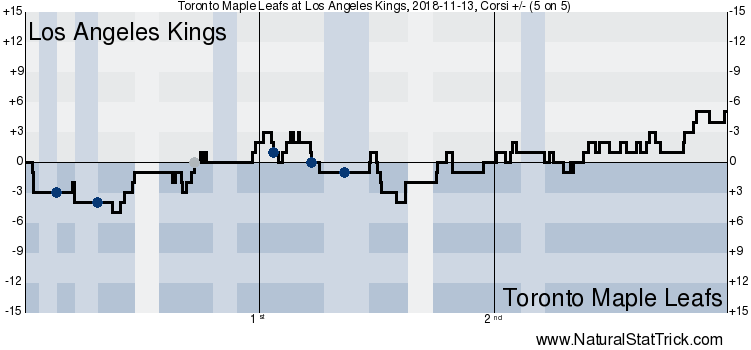The Toronto Maple Leafs started off their California road trip with a comprehensive 5-1 win over the struggling Los Angeles Kings at the Staples Center on Tuesday night.
Your game in ten:
1. The Leafs smelled blood coming into LA with the Kings in disarray and forced to start their third-string goaltender, and they pounced accordingly. They came out flying, firing 11 shots on goal before the Kings notched their first. Refreshing given their relative lack of power-play opportunities this season, they also drew two penalties in the early going and capitalized on both.
Fast starts have become a trend for the Maple Leafs of late in a welcome reversal from the lackadaisical starts of the first few weeks of the season. They outshot the Bruins 20-6 in the first period on Saturday, including a 15-2 run to open the game, and also outshot the Devils 15-6 in the opening 20 minutes two games ago.
For those unable to do the mental math, the Leafs have outshot the opposition 51-21 in first periods of the past three games. For a team that is yet to lose a game after scoring first, it is a promising development that they’re now starting on time.
2. This tilt was a clash between two teams that were representative of different eras. The Leafs are built on their speed and quick transition play, while the Kings play a slower, heavier, more methodical style that is more reliant on D-to-D passes rather than the quick-ups that have become essential to “playing fast” in the modern game.
With an aging core and an identity that was built around Daryl Sutter hockey and has lost effectiveness with the changing times — even their best players in Kopitar, Carter, Toffoli, Kovalchuk, and Brown aren’t burners out there — it shouldn’t be too surprising that this game proved to be a gross mismatch as far as the pace of the two teams and how quickly each side traversed the neutral zone.
3. The Leafs power play struck twice early on to give them a lead they never relinquished. The first goal started with a perfect pass across the seam from Tavares to Marner. With Peter Budaj coming across to play the shot, Marner slid it back across to Kadri for an easy tap-in. The second goal came at the tail end of the power play as an intentional floater by Rielly was tipped in adroitly by Tavares.
A third power-play goal later arrived in Kadri’s second goal, which was a good example of how effective the Leafs power play is even when it isn’t scoring glamorous tic-tac-toe goals like the 1-0 tally, simply by funneling the puck to the net with so many layers in front.
A beautiful tic-tac-toe passing-play goal, a tip goal, and a rebound goal in front was a perfect demonstration of how effective the Leafs power play can be and how it can hurt teams in a variety of ways.
4. The Leafs’ success on the power play over the last two years has been due in no small part to the elite talent present on both units, but it is abundantly clear from the shot generation of this season’s Nylander-less second unit that Jim Hiller continues to do an excellent job of running the power play.
Hiller filled this same role for Babcock in Detroit, where he quickly helped turned a middling power play (18th in the league) into dominant one (2nd in the following season), and he had a similar effect on Toronto’s power play when he first arrived.
The effect of the coaching is more pronounced when a group featuring Ennis, Leivo, Johnson, Marleau/Kapanen, and Gardiner can be as effective as they have as far as their ability to gain the zone cleanly, work the puck around, and direct shots at the net. These are well-drilled units, and even if the second one doesn’t score, they generally keep the momentum tilted in the team’s favour.
Looking at some of the other top power plays in the league, only Tampa Bay’s second unit can generate shots nearly as effectively as Toronto’s, and that’s a group that includes Yanni Gourde, Brayden Point, and Tyler Johnson. All of the other teams feature a much sharper drop-off that is more representative of the chasm of skill between most teams’ first and second units.
| First unit (CF/60) | Second unit (CF/60) | |
|---|---|---|
| Winnipeg | 150 | 61 |
| Toronto | 129 | 100 |
| Tampa | 122 | 98 |
| Boston | 118 | 50 |
| Washington | 109 | 68 |
5. So what exactly makes Hiller’s power plays so effective? We’ve seen how they effectively utilize the cross-seam pass and the use of the “bumper” role in the middle of the ice. Moreover, his power plays don’t rely much on the traditional threat of a slapshot from the blueline. Instead, if the defenseman gets involved with a shot, it’s through layered screens looking for a tip or rebound, and the unit is built around creating those outnumbered situations at the net front after funneling pucks to that area.
Hiller’s scouting of the opposing team’s is also really thorough, as referenced in an article by David Alter last year:
Leafs players say that Hiller spends much of his time analyzing opponents’ tendencies. Before each game, he’ll pick apart the other team’s penalty kill strategies and help his power-play units find a path to the net.
During games, Hiller is typically keeping track of situations in the offensive zone when a scoring chance doesn’t result in a goal. He will then tell Leafs players what the opposition is doing to adjust to Toronto’s offence midgame.
6. Kasperi Kapanen continues to shine in his expanded role with another strong showing on the night, as his speed was a constant threat both at even strength and on the penalty kill. It seems likely that Kapanen will remain on Kadri’s wing when Matthews and Nylander eventually find their way back into the lineup. Presumably, with everyone healthy (and signed), Kadri’s line could comprise a vastly improved third unit, although it’s not clear what the Leafs will do on the left side given Kadri’s chemistry with Marleau.
When Marleau – Kadri – Kapanen is the Leafs' third line, which Matthews and Nylander returning gets them 2/3rds of the way there, they'll have the best top-9 in the league. Be nice to add the right LW piece to round it out (Maroon at the deadline?).
— Alec Brownscombe (@MapleLeafsHS) November 14, 2018
7. Igor Ozhiganov restored some hope for Kings fans late in the first period with a pizza pie up the middle of the ice to Dion Phaneuf. A tipped shot later via Adrian Kempe and the Kings pulled within one on the scoreboard, but for anyone watching the game, with the shot count at 16-8 for the period and the obvious lack of pushback by the Kings, this one already felt like it was over, 2-1 goal aside.
Great teams don’t play down to opponents often, and in that respect, this was a business-like performance from the Leafs. The Kings are a feeble opponent right now, but the Leafs never gave them a foothold into the game and the result was never really in doubt at any point.
8. The Leafs blew it open completely in the second beginning with an impressive burst of speed and hustle by Zach Hyman to negate an icing, something we’ve seen him do several times before. After some control in the slot by Tavares, he sent it low-to-high to Morgan Rielly, who put it in off the bar in a continuation of his dream start to the year.
Apart from the obvious evolution of his overall game in conjunction with the abundance of talent surrounding him on this squad, some other significant changes have fueled this run. His shot rate has spiked drastically; he has always had an accurate enough wrist shot, but he’s getting it off more willingly, in better spots, and with a little more zip. Rielly already has eight goals to show for it — one shy of his career high in just 18 games played — and he is showing no real signs of slowing down any time soon.
There is also a difference worth noting in the deployment by the coaching staff: Babcock and co. have given Gardiner and Zaitsev heavier defensive starts so far this year. It’s allowed the more effective offensive duo of Rielly and Hainsey (who is also off to a respectable start offensively) to go to work, and it also has the benefit of reducing Hainsey’s workload (down nearly two minutes per game) to preserve him for hockey in the spring.
| 2016-2017 | 2017-2018 | 2018-2019 | |
|---|---|---|---|
| Shots per game | 2.25 | 2.39 | 3 |
| Offensive zone start % | 45 | 48 | 54 |
9. On the other hand, Travis Dermott is a blueliner that has probably earned additional ice time. Tonight, Dermott actually ended up leading the team in that respect as Babcock gave the youngster more leash and saved the legs of his top four with the multi-goal advantage. His offensive prowess was on display as he danced past a beleaguered Jeff Carter walking in off the blue line before sliding it across to Andreas Johnson for an easy fourth Toronto goal. For a team that relies on the stretch pass as much as the Leafs, you’d think they would use one of the best stretch passers in the league (and certainly on the team) more often.
10. Ho-hum, just another two-point night for Nazem Kadri, who picked up two goals to move to 13 points on the season. Even with a slow start production-wise, Kadri has been effective and engaged since day one and continues to be a high-end top-six center and more-than-adequate fill in for the injured Matthews — just as he was last season when Matthews went down and the team kept on winning games.
The Leafs are humming along nicely without Matthews, and a lot of the credit will (rightfully) go to Tavares, but the same thing happened last year when Matthews went down, and one of the biggest common threads is Nazem Kadri. Who has been amazing tonight and good all year.
— Alec Brownscombe (@MapleLeafsHS) November 14, 2018
It’s the nature of the Toronto market that negativity can often pervade the discussion even as the team does well. Despite the frustrations surrounding the absence of two of the team’s young stars, they sit near the top of the league standings and are sailing along at 12-6-0. Playing a team in the Kings that is in the uncomfortable phase of a downward descent into a rebuild serves as a reminder of how far this franchise has come since the days that Dion Phaneuf wore the ‘C’ for the Maple Leafs. The once-dreaded Death Valley road trip — which once upon a time broke the Leafs will and sent their season over the cliff face during the Carlyle era — doesn’t seem at all daunting anymore.
Game Flow: 5v5 Shot Attempts





































